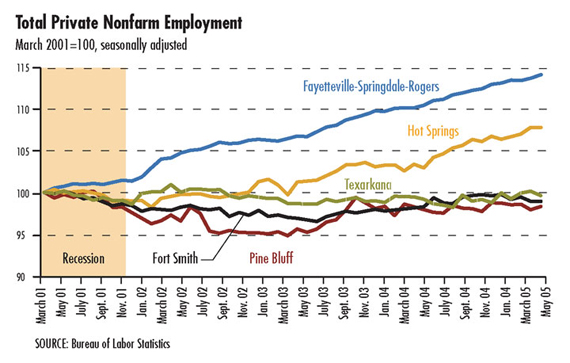District Overview: Fayetteville and Hot Springs Lead the Recovery in Employment
Among the five metropolitan statistical areas (MSAs) outside Little Rock-North Little Rock, only Fayetteville-Springdale-Rogers experienced job increases (3.2 percent annual on average) both during and after the 2001 recession. Employment in Hot Springs, a newly classified metropolitan area, has also recovered well from the recession, growing at a solid annual rate of 2.5 percent since March 2002. However, the remaining MSAs (Fort Smith, Pine Bluff and Texarkana) have undergone a "jobless recovery," where labor market performance has remained dismal despite an improving economy. These disparate employment trends characterize the changing economic landscape in Arkansas.
The Fayetteville-Springdale-Rogers MSA is located in the Ozark region-the extreme northwestern upland portion of Arkansas-and consists of three Arkansas counties, Benton, Washington and Madison. It lacks the Delta's rich soil and the industrial base of the state's centrally located capital, and only 50 years ago was the poorest area of the state. The economic wheel began turning and picking up speed when several entrepreneurial and ambitious Arkansans started building world-class companies in Ozark towns-Don Tyson's Tyson Foods Inc. in Springdale and Sam Walton's Wal-Mart Stores Inc. at Bentonville, among others. By the 1990s, the MSA's population was growing rapidly (47.5 percent between 1990 and 2000), and jobs were being created at an even faster rate.
Employment growth in the Fayetteville MSA since the recession has been uniformly strong in almost all sectors. Except for a slight decline in manufacturing, which was still mild compared to Arkansas' decline as a whole, job creation has been particularly strong in the natural resources, mining and construction sector (36 percent from March 2001 to June 2005), education and health services (24 percent), and the trade, transportation and utilities sector (21 percent). Between June 2004 and June 2005, Fayetteville added 13,675 workers, more than 1,000 workers per month. Some of this gain came from unemployed people getting jobs, but most was due to emigration from other parts of Arkansas or from other states.1 The unemployment rate in Fayetteville stood at 3.4 percent in June, the lowest in the state and well below the national average of 5 percent.

On the other hand, in the remainder of the zone and especially in central Arkansas, the post-recession employment recovery has been a mixed picture, including declining employment in Pine Bluff, stagnating employment in Fort Smith, Pine Bluff and Texarkana, and increasing employment in Hot Springs.
Hot Springs, which consists of only Garland County, has outperformed its neighbors, thanks to especially solid job increases in professional and business services (27 percent) and leisure and hospitality (25 percent). It was ranked No. 14 among the nation's MSAs that had the fastest job growth based on change in nonfarm payroll employment between June 2004 and June 2005.
In contrast, Fort Smith was hit especially hard in the financial activities sector, which has declined by more than 15 percent since March 2001. Texarkana also experienced a decline of over 7 percent in natural resources, mining and construction employment. However, increases in government employment of over 10 percent in both Fort Smith and Texarkana helped to counterbalance hese declines. The employment outlook in Pine Bluff, which sits adjacent to Little Rock-North Little Rock, is equally bleak. Since March 2001, the metropolitan area has lost 35 percent and 15 percent of jobs in the information sector and the manufacturing sector, respectively. In June 2005, its unemployment rate of 7.3 percent was the highest in the state. On a more positive note, professional and business services grew over 27 percent.
Fayetteville still has some way to go, but if the present trends continue it may become the largest economic force in the zone. For example, Fayetteville's share in total Arkansas employment has increased from 11 percent to 17 percent in the past 15 years, with improvement in every sector.
Endnotes
- Northwest Arkansas' News Source, July 20, 2005. See www.nwanews.com. [back to text]
Views expressed in Regional Economist are not necessarily those of the St. Louis Fed or Federal Reserve System.
For the latest insights from our economists and other St. Louis Fed experts, visit On the Economy and subscribe.
Email Us

